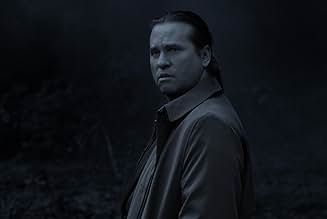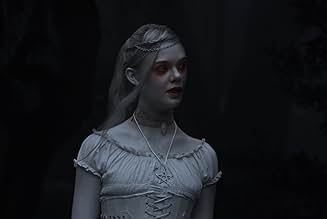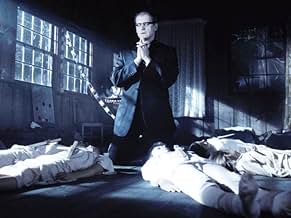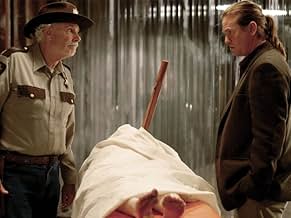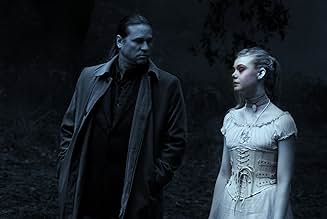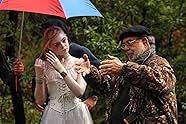Uno scrittore horror in difficoltà visita una piccola città durante un tour di un libro e viene coinvolto in un mistero di omicidio di una ragazza. Quella notte in sogno, viene avvicinato da... Leggi tuttoUno scrittore horror in difficoltà visita una piccola città durante un tour di un libro e viene coinvolto in un mistero di omicidio di una ragazza. Quella notte in sogno, viene avvicinato da un misterioso giovane fantasma di nome V.Uno scrittore horror in difficoltà visita una piccola città durante un tour di un libro e viene coinvolto in un mistero di omicidio di una ragazza. Quella notte in sogno, viene avvicinato da un misterioso giovane fantasma di nome V.
- Premi
- 2 candidature totali
Recensioni in evidenza
Hopefully B'Twixt will open this classic to a wider audience, I'm sure there are a lot of people who would appreciate this film, and give it the recognition it deserves.
I love the dreamy flow of the story. I can't think of anything that resembles B'Twixt, it's funny and spooky. The camera work and editing makes it an ethereal journey from beginning to end.
Twixt is about the creative process. If you're put off by Coppola's more indulgent films, then you're simply not going to like this one, either. Early on, it becomes apparent that this is going to be a postmodern take on Gothic tales: the film opens with a hokey narration, the town is full of quirky stock characters, and the "real world" sequences play out like an interactive story. As the film progresses, these elements grow stronger, and a surreal element breaks down the barriers between reality, dreams, and fiction. This may leave some viewers exasperated or confused, as it's a far more experimental and indulgent story than something like, say, The Godfather or Bram Stoker's Dracula. What we see is a writer trying to deal with writer's block, guilt over his daughter's death, and how to make sense of the jumble of ideas that he's got in his head. Coppola seems uninterested in telling a straight-ahead Gothic story about a homicidal priest vs vampires, but I think this is the story that audiences wanted. They're unconcerned with the creative process, themes in Edgar Allan Poe's work, or metafiction.
There are many beautiful shots in the film that make use of digital effects. Val Kilmer wanders through his dreams in a black and white world that makes occasional use of striking, bold colors. The effect is similar to the semi-monochrome of Sin City, though it's used more sparingly. Unfortunately, as striking as the cinematography is, it doesn't really live up to the legendary expectations that many have come to expect from Coppola. Like Scorsese, he seems to have became a victim of his own early success, doomed to be forever judged harshly for anything that falls short of pure genius.
Val Kilmer is obviously looking a bit older, and, yes, he's gained some weight. Regardless, I found his performance to be pretty good. I was never a huge fan of Kilmer, but he's a likable guy, and he imbues this character with the same likable qualities. His performance is a bit muted and introspective, but there are occasional hammy moments, such as when he does some rather amusing impressions during a drunken scene of writer's block. Bruce Dern was really great, and I loved his character, a spunky and reactionary sheriff who served as the foil for Kilmer's character. Dern got to be as eccentric and lively as Kilmer was quiet and repressed, and it was fun to see them work off each other. The others were good, but Dern was just so much fun that I kept wishing he'd show up in every scene, do something crazy, and keep the film a bit more lively.
For fans of Edgar Allan Poe, Gothic horror, and literary analysis, this is a fun film. Others will probably be a bit disappointed. The pacing is significantly faster than Coppola's 70s work, but it's still a bit leisurely, and the lack of a coherent narrative may alienate people who just wanted to see vampires vs serial killers in a small town full of secrets.
"B'Twixt Now and Sunrise" is Francis Ford Coppola's renamed reedit of his 2011 movie "Twixt," released in 2022. It's a mystery/dramedy with elements of horror, combining the look of Coppola's "Bram Stoker's Dracula" with the inscrutableness of his "Youth Without Youth," plus a welcome side of humor. It's a quirky mystery that leaves you scratching your head, but you find yourself enjoying the ride, a Gothic tale with beautifully haunting cinematography & atmosphere, highlighted by Poe, bell towers, ghosts and bats in the belfry. The enhanced moonlighting and otherworldly blueish gray tones are awesome.
It tackles the creative process as we observe the desperation of a writer scraping the bottom of the barrel, often under the influence of sundry intoxicants. Will he come up with a best seller? Will he solve the murder mystery? Will he come to terms with his specters and demons that arise from his guilt over what happened to his daughter? That element, by the way, brings to mind Francis' 23 years-old son, Gian-Carlo Coppola, who was tragically killed in a similar boating accident in May, 1986. The reckless driver was Griffin O'Neal (Ryan's son).
A lot of the movie is an internal dialogue with the author's own ghosts and literary influences. Charles Baudelaire (a notorious substance abuser) is referenced, with the aforementioned Poe intermittently appearing, but only when Baltimore is under the influence, or dreaming. Did the abuse and murder of the children happen as shown? Or did Poe and the vampire incarnation of Hall's own daughter serve as muses as he works his way through creating a story that might turn his career around? Coppola leaves it up to you to decide what is real and what is imagination, but the answers are there if you want 'em.
Francis got the story from a dream he had while staying in Istanbul. This sets-up the criticism that Coppola's dream is the audience's nightmare. While "Twixt" and this reedit are too ambiguous for their own good, it's obviously intentional and he wanted the viewer to leave with questions to ponder. Besides, does everything need to be spelled out?
As for comparing the two versions, this one's 8 minutes shorter and I think I liked it better (it's hard to say because I saw the former version 8 years earlier).
It was shot at Kelseyville and the Clear Lake area of Northern California.
GRADE: B+
Coppola has said in interviews that he's only making "personal" films from now on - maybe too personal. While there are elements in this film that show the master has not lost his touch, this film borders on the incomprehensible. Is it a comedy? A horror film? A psychological drama? A fantasy? Your guess is as good as mine - and, apparently, the cast's, as three participants in the film in attendance said as much in the Q&A that followed the screening. Actors Bruce Miroglio, Anthony Fusco, and Don Novello all had the same reaction after screening the film (only their second opportunity.) First, it was nothing at all like the film they saw a few months ago and Coppola was obviously still tinkering with it. Second, it was a helluva lot funnier than they remembered it.
Confusion maybe the theme of the film, but should that confusion have extended to the cast and, ultimately, the audience? One of the things the audience was confused about was that it was a 3-D film. Everyone eagerly played with the glasses until an announcement was made that there were only two short sequences in 3-D, and that it would be clear when those times were. That still didn't stop people from flipping the glasses on and off in a futile attempt to add some dimension to the film.
Coppola's choice to use 3-D does say something, though. Consider his contemporary - Martin Scorsese. Scorsese embraced the technology, used it to great effect to enhance his storytelling in "Hugo," and foresees using the process for all of his future projects. (We'll see.) How does Coppola use it? As a gimmick. An effective gimmick, but a gimmick none the less. Scorsese used it to draw you into the world of "Hugo." Coppola's use actually, and purposely, takes you out of his. Interestingly, only one of the two sequences was filmed using a 3-D camera. The second was added in post-production.
It really wasn't necessary, as the look of the film is one of its assets. Visually entrancing, and wonderfully atmospheric, the film has a cinematic look unlike anything else Coppola has done - even "Dracula." As for the cast, Val Kilmer giver a lead performance that almost redeems him from the trainwreck that is "The Fourth Dimension." I could have done without his umpteenth Brando impersonation, though. Uniformly fine work from the supporting cast helps. It's always good to have Bruce Dern back on screen portraying one of his "slightly-off" characters.
The script is the film's Achilles Heel, if Coppola even had one. I don't need every element of a story to be spoon-fed to me, but give me something to chew on, please. "Twixt" leaves too many threads dangling from the seams that are obviously fraying in this film. The parts are all there, they're just waiting to be sewn together in a much better fashion. Its ending is abrupt and confusing. As Miroglio said when responding to an audience member's comment that he really didn't know what happened at the end, "Francis' response would probably be – 'GOOD!'" Maybe for him, but not for an audience. Coppola says he got the idea for the film from a dream of his. Coppola's turned his dream into an audience's nightmare. Does he even care?
www.worstshowontheweb.com
Lo sapevi?
- QuizDirector Francis Ford Coppola had originally intended the film as a type of "live editing" experiment using groundbreaking digital editing technology. Coppola intended to act as a sort of conductor during every screening of the film, lengthening or shortening scenes and even changing plot elements depending on the audience response. This caused long delays in the film's release and ultimately proved impractical, forcing Coppola to do a locked edit of the film, integrating elements from all various permutations of the story.
- BlooperWhen Hall Baltimore first goes to the hotel in the dream he orders just a beer. The beer is set in front of him and has a large head of foam. In the next scene the foam is gone. When the scene resumes the foam is back.
- Citazioni
[first lines]
Narrator: There was, once upon a time, a town not far from a big city. A road ran through, but there were only a few businesses. A coffee shop, a hardware store, a sheriff's office. And all kinds of people. Vagrants, run away teens, religious fanatics, retired seniors who, well, it was a town of those who wanted to be left alone. And so they were.
- ConnessioniFeatured in Twixt: A Documentary (2013)
I più visti
- How long is Twixt?Powered by Alexa
Dettagli
- Data di uscita
- Paese di origine
- Sito ufficiale
- Lingua
- Celebre anche come
- Twixt Now and Sunrise
- Luoghi delle riprese
- Aetna Springs, Pope Valley, California, Stati Uniti(Chickering hotel)
- Azienda produttrice
- Vedi altri crediti dell’azienda su IMDbPro
Botteghino
- Budget
- 7.000.000 USD (previsto)
- Lordo Stati Uniti e Canada
- 1996 USD
- Fine settimana di apertura Stati Uniti e Canada
- 1996 USD
- 2 ott 2022
- Lordo in tutto il mondo
- 649.835 USD
- Tempo di esecuzione1 ora 20 minuti
- Colore
- Proporzioni
- 1.85 : 1
Contribuisci a questa pagina








